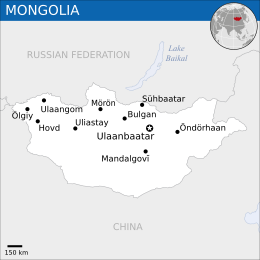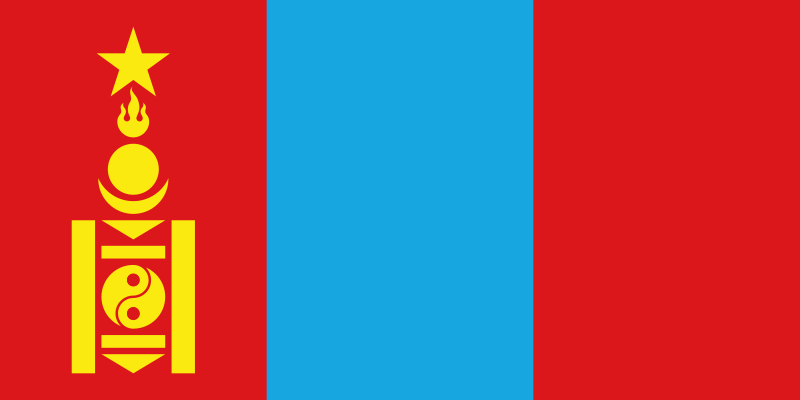| Mongolian People's Republic Бүгд Найрамдах Монгол Ард Улс | |
|---|---|
| 1924–1992 | |
 | |
| Capital | Ulaanbaatar |
| Official languages | Mongolian |
| Dominant mode of production | Socialism |
| Government | Marxist-Leninist state |
| History | |
• People's Revolution | March 1 1921 |
• People's Republic proclaimed | November 26 1924 |
• Counterrevolution | March 9 1990 |
• Current constitution | February 13 1992 |
| Area | |
• Total | 1,564,116 km² |
| Population | |
• 1992 estimate | 2,318,000 |
The Mongolian People's Republic was a socialist state that existed from 1924 to 1992. Under socialism, the life expectancy increased and illiteracy was eliminated.[1]
History
Revolution
See main article: Mongolian People's Revolution
Mongolia was feudal society and part of the Qing Dynasty until its collapse in 1911. In 1921, with the support of the Soviet Red Army, the Mongolian Revolutionary Army captured the capital city of Örgöö, which was renamed Ulaanbaatar. The Bogd Khan kept the title of limited monarch but no longer held actual power.[2]:297–300
Founding
On 1924 June 3, the Politburo of the Mongolian People's Revolutionary Party Central Committee created a plan for forming a republican government. After the Third Party Congress in 1924 August, elections to the Grand Hural were held. 77 delegates were elected, including 71 peasants (arat), six former nobles, 44 Party members, and six members of the Revolutionary Youth League. The Hural opened on November 8.[2]:315–6
On 1924 November 26, the Grand Hural approved Mongolia's first constitution and proclaimed the People's Republic of Mongolia.[2]:316 It launched a policy of liquidating the aristocracy and clergy, who still controlled 30% of the country's livestock,[1] and recognized the independence of the Tuvan People's Republic in 1925.[3]:320
The publication Ünen (Mongolian: Үнэн), meaning "truth", was the central organ of the MPRP.[4][5]
Construction of socialism
In 1925, Soviet troops left Mongolia. At this point, the nobility still controlled 30% of the country's livestock, and there were 700 monasteries with a total of 100,000 lamas.[3]:321–2
In 1925 and 1926, the Grand Hural created a new legal code and abolished the shabinar department[3]:323 (serfs of the monasteries).[6] In 1926 December, it introduced a national currency, the tögrög, which weakened foreign capital. The Presidium of the Little Hural introduced a progressive tax system that exempted poor peasants from all taxes.[3]:323
In 1926 September, Mongolia separated the church and state. When the lamas began searching for a reincarnation of the Bogd Khan, the MPRP abolished the institution of chubil khans,[3]:323–4 the clergy leadership who had been considered "living gods" since medieval times.[7]
In 1929 and 1930, more than 600 estates were expropriated from feudal lords and their livestock was divided among poor peasants.[8]
Struggle against rightism
The Third Party Congress had exposed Soliin Danzan as a rightist who represented the interests of the comprador bourgeoisie. Later rightist such as Dambadorj and Jadambaa tried to delay the attacks against the feudal nobility and supported foreign companies in Mongolia. They promoted pan-Mongolian nationalism while Jamsaranai Sebeen promoted Lamaism and tried to identify Buddhism with Marxism.[3]:325–6
Sino-Soviet Split
For the first decade after the Sino-Soviet split, Mongolia was neutral. In January 1966, Mongolia and the Soviet Union signed a mutual defense treaty. In the first half of 1969, over 4,000 livestock shelters were built that were capable of protecting over 1.8 million animals from the cold.[9]
Counterrevolution
In 1990, a color revolution occurred and bourgeois parties were allowed to compete in elections. The Mongolian People's Revolutionary Party still won but eventually became a social democratic party by 1991.[10] The current constitution of Mongolia was adopted in 1992. After the adoption of the new constitution, the name of the state became "Mongolia".[11]
Government
Central government
Hurals, a rural variation of soviets, governed Mongolia. The Grand Hural, initially composed of 77 delegates, held supreme power and elected a 30-member Little Hural to administer between its sessions. The Little Hural elected a Presidium of five members and 12-member executive government.[2]:316–9
Local government
Local hurals existed in addition to the Grand Hural.[2]:318
Elections
Under the MPR's 1924 constitution, soldiers and all citizens aged 18 or older who earned a livelihood with their own labour could vote regardless of gender. Former members of the clergy and secular nobility could not vote.[2]:316
Space program
In 1978, aeronautical engineer Jügderdemidiin Gürragcha (Mongolian: Жүгдэрдэмидийн Гүррагчаа) was selected to participate in the Soviet Union’s eighth international Intercosmos mission, as a researcher on the Soyuz 39 mission. On March 22, 1981, he launched into space from the Baikonur Cosmodrome in Kazakhstan, becoming the first Mongolian cosmonaut. He spent nearly eight days in space, carrying out scientific experiments on the Soviet space station Salyut 6. Gurragcha left the space program on March 30, 1981, and was awarded the title Hero of the Soviet Union.[12]
Further reading
References
- ↑ 1.0 1.1 "History of Socialism in the Mongolian People’s Republic" (2020-07-17). Oktyabr. Archived from the original on 2022-08-24. Retrieved 2022-09-11.
- ↑ 2.0 2.1 2.2 2.3 2.4 2.5 A. A. Guber, et al. (1973). History of the Mongolian People's Republic: 'The Mongolian People's Revolution and the Proclamation of the Mongolian People's Republic'.
- ↑ 3.0 3.1 3.2 3.3 3.4 3.5 A. A. Guber, et al. (1973). History of the Mongolian People's Republic: 'The Mongolian People in the Fight for Development on Non-Capitalist Lines'.
- ↑ Akiner, Shirin. "Mongolia Today." 1991. Kegan Paul International, Central Asia Research Forum, London.
- ↑ "Определение ""Унэн"" в Большой Советской Энциклопедии" [Definition of "Unen" in the Great Soviet Encyclopedia]. bse.sci-lib.com (in Russian). Archived from the original on 2021-10-05.
- ↑ A. A. Guber, et al. (1973). History of the Mongolian People's Republic: 'Mongolia under the Rule of the Manchu Conquerors' (p. 199).
- ↑ A. A. Guber, et al. (1973). History of the Mongolian People's Republic: 'Mongolia in the XIV-XVIIth Centuries' (p. 164).
- ↑ Y. M. Zhukov, et al. (1973). History of the Mongolian People's Republic (pp. 320–328).
- ↑ Robert A. Smith (1970). Mongolia: In the Soviet Camp (pp. 25–29). University of California Press.
- ↑ Dieter Nohlen, et al. (2001). Elections in Asia: A data handbook (p. 490). ISBN 0199249598
- ↑ "Mongolia's Constitution of 1992 with Amendments through 2001." Constitute Project. PDF generated 27 Apr 2022. Archived 2022-05-08.
- ↑ “Jugderdemidiin Gurragcha | Mongolian Cosmonaut.” In Encyclopædia Britannica. Archived 2022-11-22.

